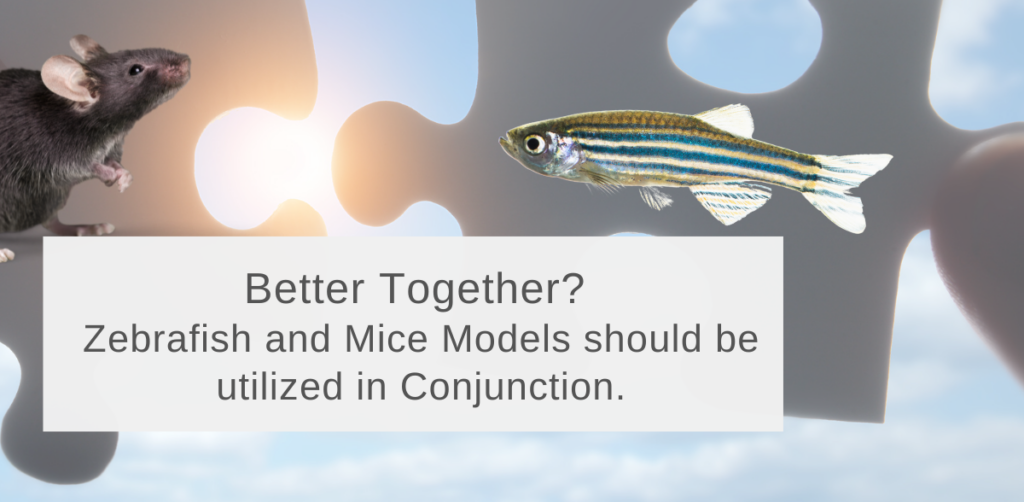Summary:
As personalized medicine and the discovery of de novo variants that cause disease continue to grow, researchers are increasingly in need of alternative models to study specific genes and accelerate drug development. Zebrafish offer an in vivo alternative animal model that can be used in conjunction with mice models to advance science. In this article we will discuss zebrafish and mice models, and how researchers can leverage them together to better understand diseases.
In the first part of this blog series, we discussed the benefits of utilizing zebrafish in a range of research fields including anti-inflammation research, rare disease research, neuroscience research, and as a tool for drug discovery. A less talked about utilization of a zebrafish model, is perhaps, one of their greatest strengths: being used as a first step for researchers to test hypotheses and run large screens that would be extremely expensive and time consuming in mice, before moving to a traditional mammalian model. While there has been a push to move to alternative model organisms in research, mice still make up the vast majority of models used in biomedical research (61% of procedures in the UK in 2019) (Home Office, 2019). This can partially be attributed to the fact that researchers often continue utilizing the model they conducted their PhDs under. For instance, Dr Jeffrey Aamack told 17 Minutes of Science that, “in graduate school, I was trained as a geneticist using mouse models and human cell lines, and then got into zebrafish as a postdoc, always with the idea that I would probably set up a mammalian genetics lab is, you know, if I started my own lab. But zebrafish continued to grow in and power and popularity,” so now, Aamck utilizes zebrafish to study genes and mechanisms that control organ formation during embryonic development.
I realized that, well, you know, everyone thinks someone else's model is uninteresting and their own model is spellbinding (...) [but] I see fish as a complement to existing models. It brings a different set of tools.
Dr Noebels
Zebrafish offer a particular benefit for being used in drug discoveries, where they can be utilized in conjunction with a traditional mammalian mouse model to vastly accelerate the drug discovery timeline. Since drug development takes, on average, 7-10 years and $500 million to develop, incorporating zebrafish into drug research could be incredibly impactful (Ogbru, 2020). This timeline and cost can largely be attributed to the mouse model, as mice have long lives and are expensive to house and feed.
You can test a lot of molecules fairly rapidly. That is a key strength of zebrafish, the ability to do those large scale assays that it’s much harder and more importantly, very expensive to do with rodents.
Dr Bosse
Recently, the FDA recognized the flaws in our current drug discovery pipeline, announcing that mammalian testing is no longer required before bringing a drug to trial, in an effort to bring down drug timelines and costs. This being said, many of the alternatives that the FDA Modernization Act 2.0 mentions, such as organs-on-chips, and computer modeling, are not yet at the point where they can fully implemented in lieu of an in vivo model. And thus, mammalian models are still considered a crucial step to studying drug efficiency.
How zebrafish and mice compare
While zebrafish and mice may initially appear to greatly differ, in actuality, these models often produce similar results. For instance, Kozioł et al., (2021) aimed to evaluate the antiparkinsonian activity of xanthotoxin, a compound isolated from Pastinaca sativa fruits, in both models, and found that xanthotoxin reversed locomotor impairments in both models, suggesting it may have potential as a lead compound for the development of antiparkinsonian drugs. Furthermore, the similar activity of the compound in both models also indicates the compatibility of using zebrafish models for in vivo bioassays. Likewise, Lin et al., (2015) found that CeO2 Nanoparticles have similar hazard potential in mouse lungs and zebrafish gastrointestinal tracts.
How to Leverage a Multi-model Approach
In the past two decades human and neurogenetics and personalized medicine has exploded. Rare disease research is an area which can especially benefit from the use of zebrafish as a preliminary model organism, as rare disease patients often have limited funding and a shortened timeline compared to big pharma. Thus, using zebrafish, researchers can gain a more comprehensive understanding of the genetic and molecular basis of various diseases, and potentially identify new therapeutic targets for the treatment of those diseases quickly, before moving to mice.
The way things are moving forward, that people are getting personalized models made of their gene. They put [the genes] into mouse, into zebrafish, various animals that allow you to rapidly screen the effectiveness of certain drugs and find out, you know, importantly which drugs might be better, but also which ones to avoid because some medicines make you worse (...) many more models are needed to really get a grip on these diseases.
Dr Noebels
One resource which is making this easier is ModelMatcher, an online platform which aims to promote cross-disciplinary collaborations, especially between scientists and other stakeholders of rare and undiagnosed disease research (Harnish et al., 2022).
Conclusion:
Thus, zebrafish can act as a first step for researchers to accelerate their research before moving into a mammalian mouse model. Moving forwards, zebrafish should be used in conjunction with mice models to better understand diseases and provide a cost-effective and time-efficient approach to drug discovery. This being said, zebrafish aren’t always in-house and accessible to researchers. If researchers don’t have the capability to use a zebrafish model, they can use a CRO (contract research organization) like InVivo Biosystems to achieve their needs.
Reach out to InVivo Biosystems today to see how we can help you meet your research needs.
References:
- Home Office (2019). The Annual Statistics of Scientific Procedures on Living Animals, Great Britain 2019. https://speakingofresearch.files.wordpress.com/2020/07/annual-statistics-of-scientific-procedures-on-living-animals-great-britain-2019.pdf
- Lin, S., Wang, X., Ji, Z., Chang, C. H., Dong, Y., Meng, H., Liao, Y. P., Wang, M., Song, T. B., Kohan, S., Xia, T., Zink, J. I., Lin, S., & Nel, A. E. (2014). Aspect ratio plays a role in the hazard potential of CeO2 nanoparticles in mouse lung and zebrafish gastrointestinal tract. ACS nano, 8(5), 4450–4464. https://doi.org/10.1021/nn5012754
- Kozioł, E., Skalicka-Woźniak, K., Michalak, A. et al. Xanthotoxin reverses Parkinson’s disease-like symptoms in zebrafish larvae and mice models: a comparative study. Pharmacol. Rep 73, 122–129 (2021). https://doi.org/10.1007/s43440-020-00136-



